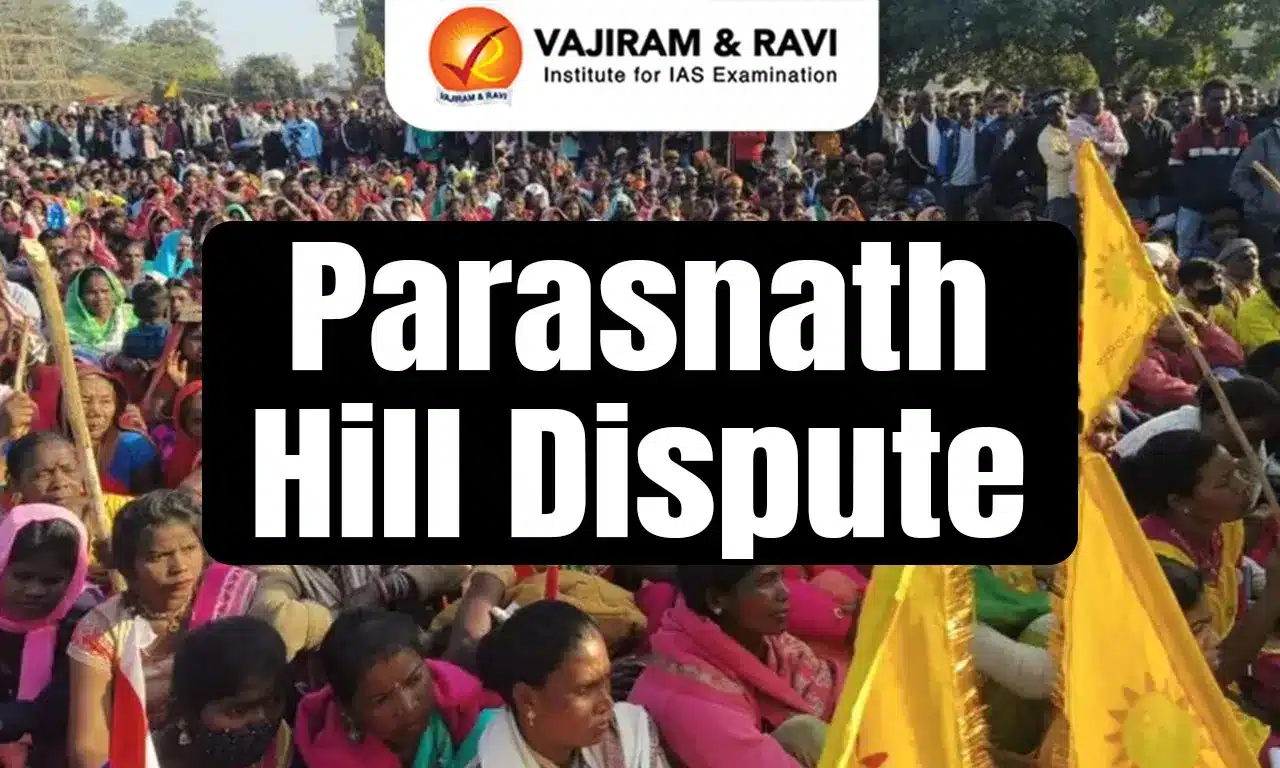What’s in Today’s Article?
- Parasnath Hill Dispute Latest News
- A Sacred Hill Revered by Two Communities
- An Old Conflict Over Sacred Rights
- Situation After Independence
- Parasnath Hill Dispute FAQs
Parasnath Hill Dispute Latest News
- The Jharkhand High Court directed the state government to enforce an existing ban on meat, alcohol, and other intoxicants on a sacred hill in Giridih district.
- Known as Marang Buru to the Santal Adivasi community and Parasnath to Jains, the hill is a site of religious significance for both groups and has been at the center of a long-standing inter-community conflict.

A Sacred Hill Revered by Two Communities
- Jain Significance
- Parasnath Hill holds immense religious importance for Jains, as it is believed that 20 of the 24 tirthankaras, including Parshvanatha (after whom the hill is named), attained nirvana here.
- Today, the hill features over 20 Jain temples and pilgrimage sites, symbolizing its deep historical and spiritual roots in Jain tradition.
- Santal Significance
- For the Santal Adivasi community, the hill is known as Marang Buru or “Great Mountain” and is the abode of their supreme animist deity.
- It houses sacred sites like Jug Jaher Than and Dishom Manjhi Than, where vital rituals are performed.
- The hill also serves as a spiritual and cultural hub during the annual Hudur Durga festival in December.
- The tribal council Lo Bir Baisi convenes at its base to resolve major disputes.
- It was with a resolution of this council that the historic Santal Hul was launched in 1855.
- Led by Sidhu and Kanhu Murmu, the rebellion targeted the oppressive dikus (outsiders), including za- mindars, mahajans, and British officals.
- Source of Conflict
- The dual sanctity has made the hill a shared yet contested religious space between the two communities.
An Old Conflict Over Sacred Rights
- Historical Claims and Disputes
- While Jains claim that an ancient king once donated Parasnath Hill to their community, historical records challenge this.
- According to the 1957 Hazaribagh District Gazetteer, the oldest Jain temple on the hill dates only to 1765 AD.
- The formal dispute between the Santals and Jains over the hill was first documented in 1911, during the preparation of the record-of-rights.
- The Sendra Festival and Religious Friction
- A key point of contention is the Sendra festival—a three-day ritual hunt during the full moon of Baisakh, considered a rite of passage for Santal men.
- The hill, called Marang Buru by Santals, becomes the center of this religious and cultural practice.
- For Jains, who adhere strictly to non-violence and vegetarianism, this tradition is deeply troubling.
- Legal Battles and Customary Rights
- Early efforts by the Jain community to legally halt the hunting practice failed.
- In 1917, the Patna High Court dismissed the suit, terming the Jains’ grievance as “hyper sentimental.”
- Ultimately, the Privy Council—the highest court in British India—upheld the Santals’ customary right to hunt on the hill, recognizing their longstanding traditions.
Situation After Independence
- Loss of Constitutional Protections
- After India’s independence, the rights of Adivasis over Marang Buru began to decline due to increasing state control over forests and pressure from non-tribal communities (dikus).
- In 1972, the same year the Wildlife Protection Act was passed, Adivasi villages around the hill lost their Fifth Schedule status, stripping them of constitutional protections that allowed forest usage.
- Impact on Religious Practices
- This led to restrictions on traditional rituals, especially at Jug Jaher Than, the sacred Santal site.
- Between the 1970s and Jharkhand’s formation in 2000, Santals faced growing limitations on access and gatherings at the hill.
- Recent Government Directives and Legal Orders
- In 2023, the Ministry of Environment, Forest and Climate Change (MoEFCC) issued a memorandum banning alcohol, meat, and eggs within a 25 km radius of the hill—covering 99 mostly Adivasi villages—to honor Jain sentiments.
- This included restrictions in Anganwadi centers and primary schools.
- The Jharkhand High Court’s recent order enforced this directive.
Parasnath Hill Dispute FAQs
Q1. Why is Parasnath Hill important to Jains?
Ans. It’s believed 20 Tirthankaras attained nirvana here; it houses major temples and pilgrimage sites.
Q2. What does the hill mean to Santals?
Ans. Known as Marang Buru, it’s home to their supreme deity and vital for rituals like Hudur Durga.
Q3. What triggered the conflict?
Ans. Clashing religious practices—Santal hunting vs Jain non-violence—created disputes over rituals and sacred space.
Q4. What was the 2023 government order?
Ans. A ban on meat, alcohol, and eggs within 25 km to respect Jain values, affecting tribal villages.
Q5. What is the Sendra festival?
Ans. A traditional Santal hunting ritual on the hill, which Jains oppose as it conflicts with their beliefs.
Last updated on June, 2025
→ UPSC Notification 2025 was released on 22nd January 2025.
→ UPSC Prelims Result 2025 is out now for the CSE held on 25 May 2025.
→ UPSC Prelims Question Paper 2025 and Unofficial Prelims Answer Key 2025 are available now.
→ UPSC Calendar 2026 is released on 15th May, 2025.
→ The UPSC Vacancy 2025 were released 1129, out of which 979 were for UPSC CSE and remaining 150 are for UPSC IFoS.
→ UPSC Mains 2025 will be conducted on 22nd August 2025.
→ UPSC Prelims 2026 will be conducted on 24th May, 2026 & UPSC Mains 2026 will be conducted on 21st August 2026.
→ The UPSC Selection Process is of 3 stages-Prelims, Mains and Interview.
→ UPSC Result 2024 is released with latest UPSC Marksheet 2024. Check Now!
→ UPSC Toppers List 2024 is released now. Shakti Dubey is UPSC AIR 1 2024 Topper.
→ Also check Best IAS Coaching in Delhi





















